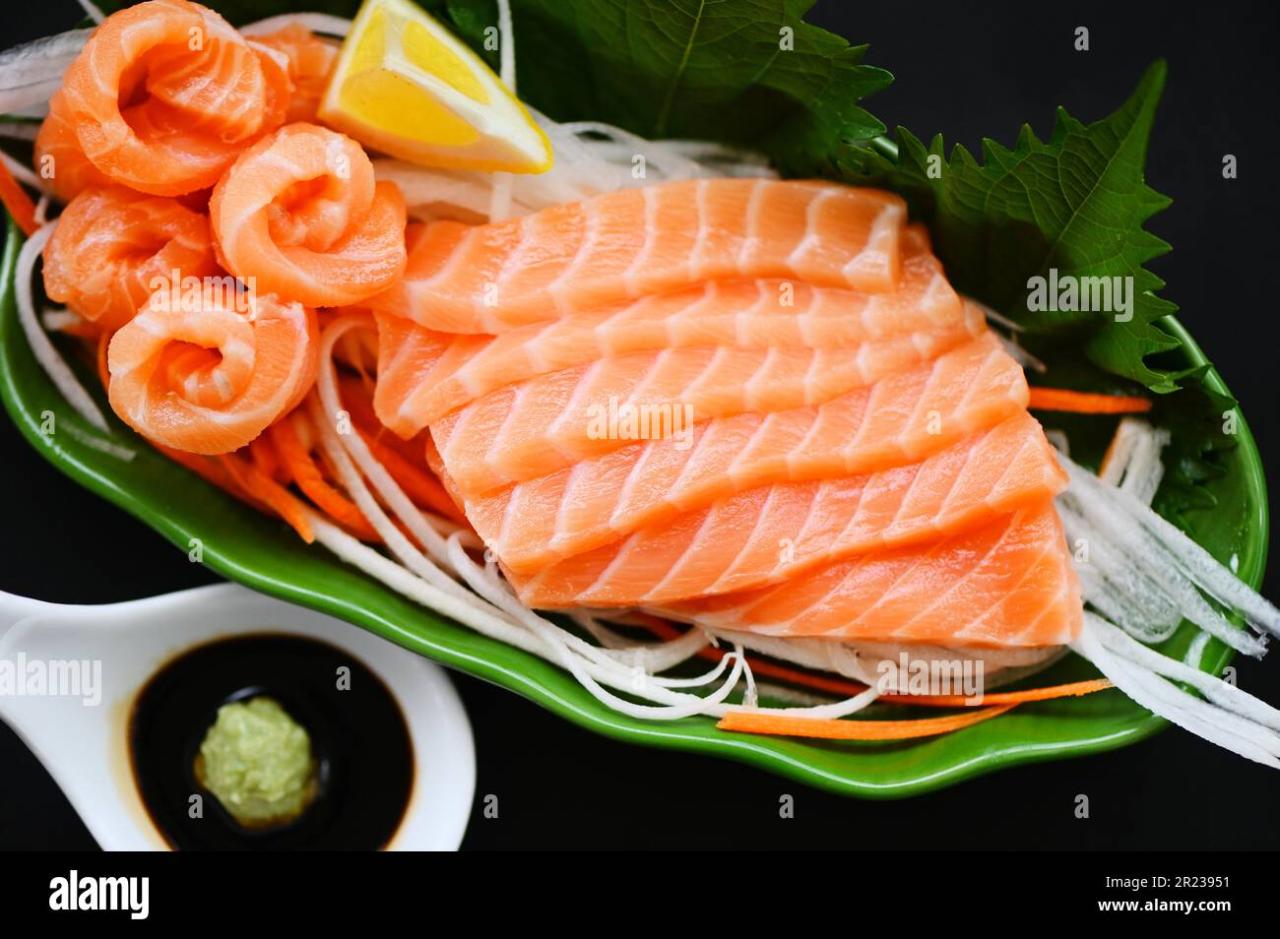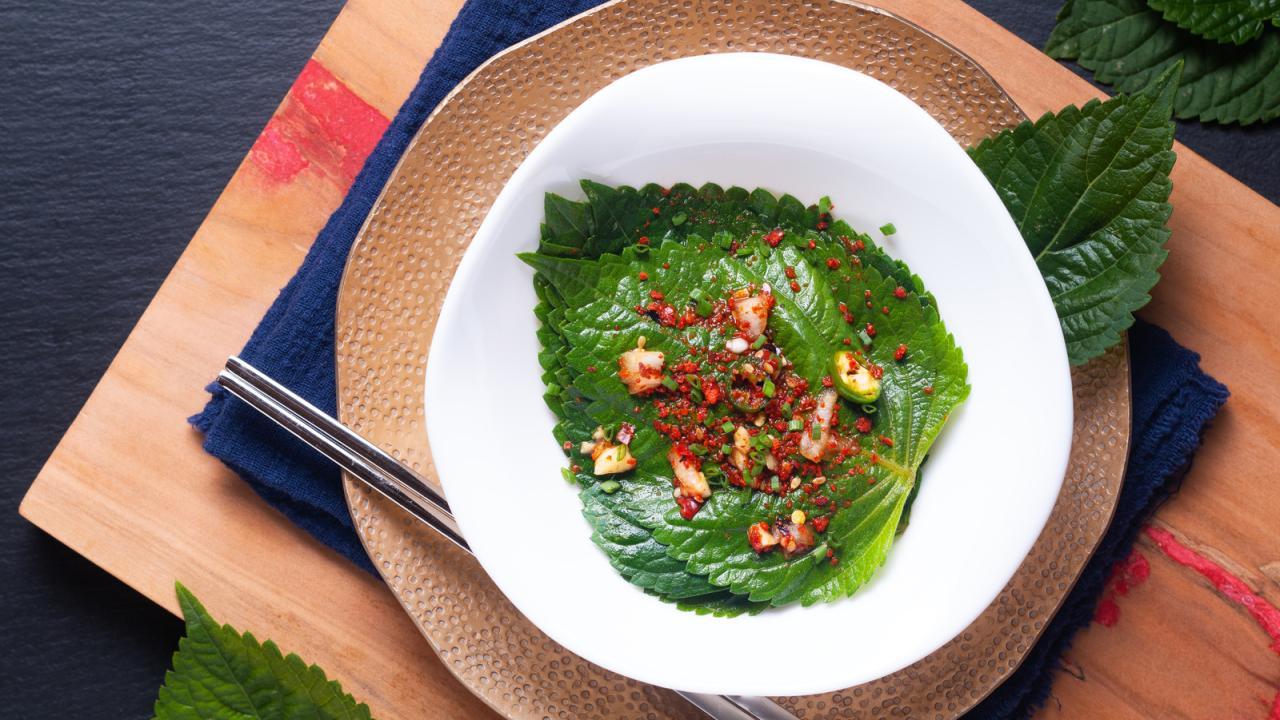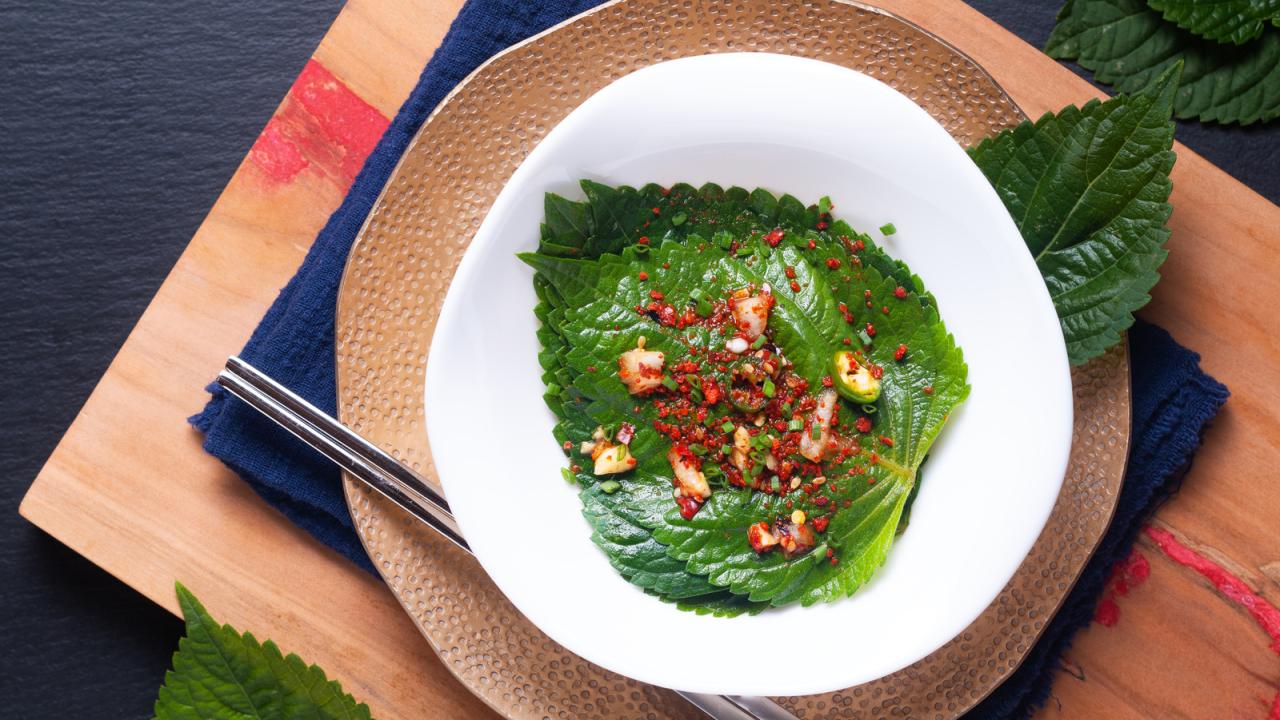Transform Your Cooking with Perilla Leaf: How to Use This Herb for Amazing Results – Perilla leaf, also known as shiso, is a versatile herb with a unique flavor profile that can elevate your dishes from ordinary to extraordinary. With a history dating back centuries, this leafy green has been a staple in Asian cuisines, and its popularity is now spreading globally.
From its distinct flavor to its impressive nutritional benefits, perilla leaf offers a culinary adventure waiting to be explored.
Beyond its traditional uses, perilla leaf is gaining recognition as a culinary powerhouse, with chefs and home cooks alike discovering its versatility in various cuisines. This article will guide you through the world of perilla leaf, exploring its history, flavor profile, nutritional benefits, and culinary applications.
Whether you’re a seasoned chef or a novice cook, this guide will empower you to unlock the secrets of this extraordinary herb.
Introduction to Perilla Leaf: Transform Your Cooking With Perilla Leaf: How To Use This Herb For Amazing Results

Perilla leaf, also known as shiso, is a versatile herb with a long history of use in Asian cuisine and traditional medicine. Its vibrant green leaves and unique flavor profile make it a prized ingredient in dishes ranging from salads and stir-fries to sushi and pickles.
History and Origins
Perilla leaf, scientifically classified asPerilla frutescens*, is a member of the mint family and originates from East Asia, particularly in countries like China, Japan, and Korea. Its cultivation dates back centuries, with evidence suggesting its use as a culinary and medicinal herb in ancient Chinese and Japanese cultures.
Perilla leaf has been a staple in traditional Asian medicine, where it is believed to possess various health benefits.
Flavor Profile
Perilla leaf offers a distinct and complex flavor that can be described as a blend of minty, citrusy, and slightly peppery notes. The leaves can be used fresh or dried, with their flavor intensity varying depending on the variety and preparation method.
Some varieties, like the purple perilla, exhibit a more pronounced minty flavor, while others have a more subtle, citrusy aroma.
Nutritional Benefits
Perilla leaf is a nutritional powerhouse, packed with vitamins, minerals, and antioxidants. It is a good source of vitamin A, vitamin C, and iron, and also contains beneficial compounds like rosmarinic acid, which has antioxidant and anti-inflammatory properties.
- Antioxidant Properties:Perilla leaf is rich in antioxidants, which help protect cells from damage caused by free radicals. These antioxidants contribute to overall health and well-being, potentially reducing the risk of chronic diseases.
- Anti-Inflammatory Effects:The presence of rosmarinic acid in perilla leaf gives it anti-inflammatory properties. This can help reduce inflammation in the body, potentially alleviating symptoms of conditions like arthritis and asthma.
- Cardiovascular Health:Some studies suggest that perilla leaf may have beneficial effects on cardiovascular health. It may help lower blood pressure and improve cholesterol levels, reducing the risk of heart disease.
Culinary Uses of Perilla Leaf
Perilla leaf, with its unique flavor and versatility, has found its way into diverse cuisines worldwide, adding a distinctive touch to various dishes. From traditional Asian dishes to modern culinary creations, perilla leaf’s adaptability makes it a prized ingredient for chefs and home cooks alike.
Traditional Uses
Perilla leaf has a long history of use in traditional Asian cuisine, particularly in East Asian countries like Japan, Korea, and China. It is often used as a flavoring agent, garnish, or ingredient in various dishes.
- Japan:In Japanese cuisine, perilla leaf is known as “shiso” and is widely used in dishes like “shiso maki” (sushi rolls with perilla leaf), “shiso-age” (deep-fried perilla leaf), and “shiso gyoza” (perilla leaf dumplings). It is also used as a garnish for sashimi and other seafood dishes, adding a refreshing and aromatic touch.
- Korea:In Korean cuisine, perilla leaf is known as “kkeut” and is used in dishes like “kkaennip muchim” (perilla leaf salad), “kkaennip jeon” (perilla leaf pancakes), and “kkaennip kimchi” (fermented perilla leaf). It is also used as a wrapping for “bibimbap” (mixed rice with vegetables and meat), adding a unique flavor and aroma.
- China:In Chinese cuisine, perilla leaf is known as “suancao” and is used in dishes like “suancao rou” (perilla leaf pork), “suancao doufu” (perilla leaf tofu), and “suancao jiaozi” (perilla leaf dumplings). It is also used as a garnish for stir-fried dishes, adding a refreshing and aromatic touch.
Modern Culinary Applications
Beyond traditional uses, perilla leaf has gained popularity in modern culinary circles, inspiring chefs to explore its potential in diverse dishes.
- Garnishes:Perilla leaf’s vibrant green color and aromatic profile make it an attractive garnish for various dishes, adding a visual appeal and flavor complexity. It can be used to garnish salads, soups, pasta dishes, and even desserts, offering a refreshing and aromatic touch.
- Flavoring Agent:Perilla leaf’s distinct flavor, ranging from minty to citrusy, can be infused into various dishes. It can be used to flavor sauces, marinades, and dressings, adding a unique depth and complexity. Chefs often use perilla leaf in infused oils, vinegars, and syrups, creating a flavorful base for various culinary creations.
Perilla leaf, with its unique flavor and versatility, can elevate your culinary creations. Whether you’re adding a vibrant touch to salads or infusing your dishes with a distinct aroma, perilla leaf offers a world of possibilities. For those seeking to extend their green thumb, Grow Ivy Everywhere! The Best Propagation Methods for Maximum Coverage provides valuable insights into maximizing plant growth.
Just as ivy can transform a space, perilla leaf can transform your cooking, adding a touch of the unexpected and delightful to your meals.
- Ingredient:Perilla leaf can be incorporated into various dishes as an ingredient, adding its unique flavor and texture. It can be used in stir-fries, salads, soups, and even baked goods, offering a distinctive taste and visual appeal. Chefs often use perilla leaf in innovative ways, creating dishes that showcase its versatility and unique flavor profile.
Perilla Leaf in Different Dishes
The versatility of perilla leaf allows it to be incorporated into a wide range of dishes, adding a unique flavor and aroma to each.
- Salads:Perilla leaf adds a refreshing and aromatic touch to salads, complementing various ingredients like leafy greens, vegetables, and fruits. Its minty and citrusy notes create a flavor contrast that enhances the overall taste of the salad.
- Soups:Perilla leaf can be used to flavor soups, adding a unique depth and complexity. Its aromatic profile complements various broth bases, from clear vegetable broths to rich and creamy soups.
- Pasta Dishes:Perilla leaf can be used as a garnish for pasta dishes, adding a vibrant green color and refreshing flavor. It can also be incorporated into the sauce, adding a unique complexity to the dish.
- Seafood Dishes:Perilla leaf complements seafood dishes, adding a refreshing and aromatic touch. It can be used as a garnish for sashimi and other raw seafood dishes, or incorporated into cooked seafood dishes, enhancing the overall flavor profile.
- Meat Dishes:Perilla leaf can be used to flavor meat dishes, adding a unique depth and complexity. It can be used in marinades, sauces, or as a garnish, complementing various types of meat, from chicken and pork to beef and lamb.
- Desserts:Perilla leaf’s unique flavor profile can be incorporated into desserts, adding a surprising and refreshing touch. It can be used to flavor ice cream, sorbets, and even cakes, creating a unique culinary experience.
Cooking with Perilla Leaf
Perilla leaf, with its unique flavor profile, offers versatility in the kitchen. Its distinct aroma and taste can elevate various dishes, adding a touch of complexity and freshness. Exploring different cooking methods can unlock the full potential of this herb, transforming your culinary creations.
Methods for Cooking Perilla Leaf
The versatility of perilla leaf allows it to be incorporated into various cooking methods, each highlighting its unique flavor and aroma. Here are some popular techniques:
Method |
Description |
Tips |
|---|---|---|
Stir-frying |
Quickly cooking perilla leaf in a hot wok with oil, often alongside other vegetables or protein. |
Add perilla leaf towards the end of stir-frying to retain its vibrant color and delicate texture. |
Grilling |
Grilling perilla leaves imparts a smoky flavor and adds a charred note to the herb. |
Grill perilla leaves over medium heat for a few minutes, turning them occasionally to ensure even cooking. |
Deep-frying |
Deep-frying perilla leaves creates a crispy and flavorful snack or garnish. |
Coat perilla leaves with a light batter before deep-frying for a crispy texture. |
Pickling |
Pickling perilla leaves preserves their flavor and aroma, resulting in a tangy and refreshing condiment. |
Use a simple brine solution with vinegar, salt, and sugar to pickle perilla leaves. |
Infusing |
Infusing perilla leaves in oils, vinegars, or alcohols imparts their distinct aroma and flavor. |
Use fresh perilla leaves for infusing, as dried leaves may have a less intense flavor. |
Tips for Preparing and Cooking Perilla Leaf
To maximize the flavor and aroma of perilla leaf, follow these tips:
- Use fresh perilla leaves whenever possible. Fresh leaves have the most vibrant flavor and aroma.
- Wash perilla leaves thoroughly before using them in any recipe.
- Avoid overcooking perilla leaves, as this can result in a bitter taste.
- Add perilla leaves towards the end of cooking to retain their bright color and delicate texture.
Pairing Perilla Leaf with Other Ingredients
The unique flavor profile of perilla leaf lends itself well to various pairings:
- Seafood:Perilla leaf’s herbaceous and slightly peppery notes complement the delicate flavors of fish and shellfish.
- Meat:Perilla leaf can add a refreshing contrast to rich and fatty meats like pork and duck.
- Vegetables:Perilla leaf pairs well with both mild and assertive vegetables, such as cucumbers, tomatoes, and eggplant.
- Rice:Perilla leaf can be used to add a unique flavor and aroma to rice dishes.
- Noodles:Perilla leaf is a popular addition to Asian noodle dishes, providing a fresh and herbaceous touch.
Recipes Featuring Perilla Leaf
Perilla leaf, with its unique flavor and versatility, can elevate many dishes. From simple salads to complex stir-fries, this herb adds a distinct, aromatic touch to your culinary creations. Explore the following recipes to discover how to incorporate perilla leaf into your own cooking.
Perilla Leaf Salad
This simple yet flavorful salad showcases the fresh, slightly minty taste of perilla leaf.
- Ingredients:
- 1 cup mixed greens (such as spinach, arugula, or romaine)
- 1/2 cup thinly sliced perilla leaves
- 1/4 cup cherry tomatoes, halved
- 1/4 cup cucumber, diced
- 1 tablespoon sesame seeds
- Dressing:
- 2 tablespoons soy sauce
- 1 tablespoon rice vinegar
- 1 tablespoon sesame oil
- 1 teaspoon honey
- 1/2 teaspoon sesame seeds
- Instructions:
- In a large bowl, combine the mixed greens, perilla leaves, tomatoes, and cucumber.
- In a small bowl, whisk together the dressing ingredients.
- Pour the dressing over the salad and toss to coat.
- Sprinkle with sesame seeds and serve immediately.
Spicy Perilla Leaf Noodles
This recipe combines the refreshing taste of perilla leaf with the heat of chili peppers for a flavorful and satisfying dish.
- Ingredients:
- 1 pound ramen noodles
- 1/2 cup perilla leaves, chopped
- 1/4 cup red chili flakes
- 2 cloves garlic, minced
- 1 tablespoon ginger, minced
- 1/4 cup soy sauce
- 2 tablespoons rice vinegar
- 1 tablespoon sesame oil
- 1/4 cup water
- Instructions:
- Cook the ramen noodles according to package directions. Drain and set aside.
- In a large skillet or wok, heat the sesame oil over medium heat. Add the garlic and ginger and cook for 1 minute, or until fragrant.
- Add the chili flakes and cook for 1 minute more.
- Stir in the soy sauce, rice vinegar, and water. Bring to a simmer.
- Add the cooked noodles and perilla leaves. Toss to coat.
- Serve immediately.
Perilla Leaf and Shrimp Stir-Fry, Transform Your Cooking with Perilla Leaf: How to Use This Herb for Amazing Results
This flavorful stir-fry features shrimp, vegetables, and perilla leaves for a complete and aromatic dish.
- Ingredients:
- 1 pound shrimp, peeled and deveined
- 1/2 cup perilla leaves, chopped
- 1/2 cup broccoli florets
- 1/2 cup carrots, sliced
- 1/4 cup onion, sliced
- 2 cloves garlic, minced
- 1 tablespoon ginger, minced
- 1/4 cup soy sauce
- 2 tablespoons rice vinegar
- 1 tablespoon sesame oil
- 1 tablespoon cornstarch
- 1/4 cup water
- Instructions:
- In a small bowl, combine the soy sauce, rice vinegar, sesame oil, cornstarch, and water. Whisk until smooth.
- In a large skillet or wok, heat the sesame oil over medium-high heat. Add the shrimp and cook for 2-3 minutes, or until pink and cooked through.
- Remove the shrimp from the skillet and set aside.
- Add the broccoli, carrots, and onion to the skillet. Cook for 3-4 minutes, or until tender-crisp.
- Add the garlic and ginger and cook for 1 minute more.
- Return the shrimp to the skillet. Pour the sauce over the shrimp and vegetables. Toss to coat.
- Add the perilla leaves and cook for 1 minute more, or until wilted.
- Serve immediately over rice.
Perilla Leaf in Different Cultures

Perilla leaf, with its unique flavor and versatility, has been cherished in various cultures around the world for centuries. Its culinary uses and cultural significance vary significantly across different regions, reflecting the diverse culinary traditions and preferences.
Perilla Leaf in East Asian Cultures
Perilla leaf, known as “shiso” in Japan, “zi su” in China, and “kkaennip” in Korea, is a staple ingredient in East Asian cuisine. It is commonly used as a garnish, flavoring agent, and even as a wrapper for various dishes.
The use of perilla leaf in East Asian cuisine dates back centuries, with evidence suggesting its cultivation in Japan as early as the 8th century. In Japanese cuisine, shiso is widely used in sushi, tempura, and sashimi, adding a refreshing, slightly minty flavor.
It is also used in pickled dishes, salads, and as a wrap for fish and vegetables.In Chinese cuisine, zi su is often used in stir-fries, soups, and dumplings, adding a distinctive aroma and flavor. It is also used in traditional Chinese medicine to treat various ailments.In Korean cuisine, kkaennip is frequently used in kimchi, a fermented cabbage dish, adding a unique flavor and texture.
It is also used in soups, stews, and as a garnish for various dishes.
Perilla Leaf in Southeast Asian Cultures
In Southeast Asian countries like Thailand, Vietnam, and Laos, perilla leaf is known as “bai toey” and is widely used in various dishes. Its fragrant leaves are often used in curries, soups, and stir-fries, adding a unique flavor and aroma.In Thai cuisine, bai toey is commonly used in desserts like “khanom chan” (steamed layered cake) and “khanom krok” (coconut pancakes).
It is also used in savory dishes like “tom kha gai” (chicken coconut soup) and “gaeng keow wan” (green curry).
Perilla leaf, with its vibrant green color and unique flavor, can add a delightful twist to your culinary creations. While you’re bringing the warmth of autumn into your kitchen with this versatile herb, why not extend that feeling to your home décor?
Add Warmth to Your Home with a Beautiful Autumn Leaf Garland – Easy Steps Inside and create a cozy ambiance with a stunning garland of autumn leaves. Once you’ve completed your decorating, you can return to the kitchen and experiment with the subtle, almost minty, flavor of perilla leaf in your dishes.
Perilla Leaf in Western Cultures
While perilla leaf is not as widely used in Western cuisine as it is in East and Southeast Asia, its popularity is gradually increasing. Chefs and home cooks are discovering its unique flavor and versatility, incorporating it into various dishes.Perilla leaf is often used as a garnish for salads, pizzas, and pastas, adding a refreshing and slightly minty flavor.
It is also used in sauces, marinades, and as a flavoring agent for grilled meats and fish.
Last Recap
From stir-frying to pickling, perilla leaf offers a world of culinary possibilities. Its unique flavor profile, ranging from peppery to minty, adds depth and complexity to dishes. Whether you’re adding a vibrant garnish to your next sushi roll or infusing your favorite oil with its aromatic essence, perilla leaf is sure to become a culinary staple in your kitchen.
Embrace the versatility of this extraordinary herb and embark on a culinary journey that will transform your cooking and delight your taste buds.
FAQ Resource
What does perilla leaf taste like?
Perilla leaf has a complex flavor profile that can vary depending on the variety and how it’s prepared. It can be described as a combination of peppery, minty, and slightly citrusy.
Where can I find perilla leaf?
Perilla leaf can be found at Asian grocery stores, specialty markets, and some well-stocked supermarkets. It’s also often available online.
How long does perilla leaf last?
Fresh perilla leaf can be stored in the refrigerator for up to a week, wrapped in a damp paper towel. It can also be dried or frozen for longer storage.
What are the health benefits of perilla leaf?
Perilla leaf is a good source of antioxidants, vitamins, and minerals. It has been linked to various health benefits, including improved heart health, reduced inflammation, and enhanced brain function.
